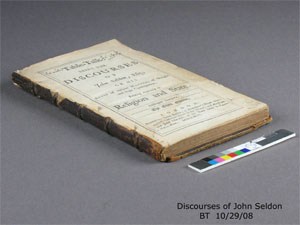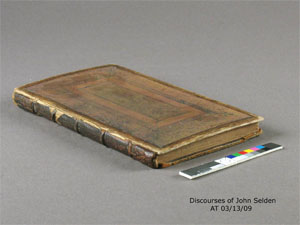Replacement Frontboard and Spine Repair
John Selden. Table-talk: Being the Discourses of John Selden, Esq.: or His Sense of Various Matters of Weight and High Consequence, Relating Especially to Religion and State. 3rd ed. London: Jacob Tonson, and Awnsham and John Churchill, 1716.

John Selden (1584-1654) was educated at the free grammar school at Chichester and at Oxford. Called to the bar in 1612, Selden rarely appeared in court, although his practice as a conveyancer and consulting counsel was successful. However, it was as a scholar and writer, often a controversial one, that Selden won his reputation. During the course of his life he produced more than thirty published works, and is regarded as one of the great luminaries of the Stuart period. Table Talk was published posthumously, and although it was possibly Selden’s best known work, it was the product of Richard Milward, Selden’s secretary.
Brief Summary of Conservation Treatment
Conserved by: Sonya Issaeva Length of Treatment: 20 Hours
 The binding is a full leather tightback and tight joint binding with three sawn-incords connecting the laced onboards and with blind tooling on the remaining board. The front board was missing and the spine leather covering was partially missing .
The binding is a full leather tightback and tight joint binding with three sawn-incords connecting the laced onboards and with blind tooling on the remaining board. The front board was missing and the spine leather covering was partially missing .
Ms. Issaeva created a new frontboard by scanning the existing backboard and printing it in color on archival paper and attaching it to a newly constructedboard.The area outside the scan was toned with watercolor pigments to mimic the existing board and burnished with a bone folder to add some surface sheen. She lifted the head and tail panels of the leather spine covering up to the first band) and scraped the spine scraped and lined it with tissue. She then lined the exposed portions of the spine with cotton fabric, which provided an attachment for the new frontboard. Finally, she covered the exposed cotton lining at the head and tail of the spine with toned Japanese tissue, and attached the lifted spine panels. Diluted acrylic pigments were applied to the toned tissue with a small brush to achieve better aesthetic integration. A custom book shoe of blue museum board completed the treatment.
For more information see the full Conservation Treatment Report


